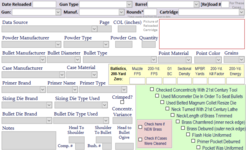I didn't realize I'd be stepping on people toes! All I thought was if you had to pull factory ammo it might be nice to know what powder it was.
Calm down.
And no worries, I'm fine with the ammo I roll. Jesus Christ man. Didn't realize I was being so offensive.Why would you want to make someone elses ammo? Why not make your own? Oh, I get it you want the gratification with out the effort. If you like my ammo then buy it, if you think you can do better/faster/cheaper then by all means do so.
Calm down.













